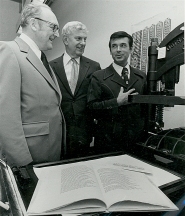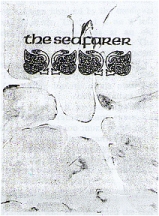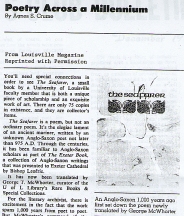
The First and Only Weekly Online Fanzine Devoted to the Life and Works of Edgar Rice Burroughs |
 |

The First and Only Weekly Online Fanzine Devoted to the Life and Works of Edgar Rice Burroughs |
 |

A Review From Louisville Magazine and Arts Club Bulletin:
December 1976
POETRY ACROSS A MILLENNIUM
by Agnes S. Crume


You'll need special connections in order to see The Seafarer, a small book by a University of Louisville faculty member that is both a unique piece of scholarship and an exquisite work of art. There are only 75 copies in existence, and they are collector's items.The Seafarer is a poem, but not an ordinary poem. It's the elegiac lament of an ancient mariner, written by an unknown Anglo-Saxon poet not later than 975 A.D. Through the centuries it has been familiar to Anglo-Saxon scholars as part of The Exeter Book, a collection of Anglo-Saxon writings that was presented to Exeter Cathedral by Bishop Leofric.
It has now been translated by George T. McWhorter, curator of the U of L Library's Rare Books & Special Collections.
For the literary archivist, there is excitement in the fact that the work spans 1,000 years from poet to poet. But McWhorter's command of the poetic idiom is such that the poem can well stand on its merits even without the dimensions of linguistic and historical scholarship.
McWhorter's interest was aroused in 1974 when he took a course in the Bibliography of English Literature and Anglo-Saxon Language. Anglo-Saxon and what is popularly known as 'Old English' are contemporaneous - dating from about 450 to 1100, give or take a century.
"I had known about The Exeter Book but had never studied it until then. It was written during one of the 'baby Renaissances' -- a brief flowering of culture in the Kingdom of Mercia, then part of the British Isles. It may not have been from one hand only -- there was much oral tradition in poetry then, and late copyists may have added the homiletics -- or sermonizing -- in the second half of the work," says McWhorter.
"There had been earlier translations, including a partial one by Ezra Pound. But Pound's version was typically brooding and morose, and I wanted to do something musical in modern verse."
McWhorter is something of a Renaissance man himself and a professional musician. From early training as choirboy at Washington's National Cathedral, he pursued studies at the Curtis Institute of Music with Metropolitan Opera baritone Richard Bonelli and in Paris with Pierre Bernac and Nadia Boulanger. He holds degrees in voice from the Eastman School of Music and the University of Michigan. (Subsequently he earned degrees in library science to serve his major interest in literature.) McWhorter sang for six seasons with the New York City Center OPera, appeared regularly with the New York Pro Musica and Radio City Music Hall, and did much concertizing. He had a leading role in the Kentucky Opera Association's production of Jenufa.
So the lyric sensibility was already strong when he undertook the project. But first, there was a lot of homework to do.
"I familiarized myself with the original poem in Anglo-Saxon, immersing myself in the style in order to write something comparable in English. At first I had to look up every other word in an Anglo-Saxon dictionary -- and, of course, no one really knows how the words were pronounced, though there are educated guesses."
For openers, McWhorter translated the long poem word for word, noting all possible variations and meanings from available concordances. Then he manipulated the words into modern English sentence structure and condensed some long, laudatory passages that seemed extraneous.
"I began to read the material out loud to myself, over and over, trying to 'feel' with the original poet. English is so rich in words with specific meanings that I was sometimes able to find synonyms that were more poetic or musical than those I'd first set down. And wherever possible, I sought alliteration (sequences of words beginning with the same sound) that corresponded to the alliteration in the original. Anglo-Saxon is the basis of our modern language; it's sparse, economical, very explicit, having an almost religious fixity, and I tried to duplicate those qualities."
McWhorter then blocked out the meter -- most of the poem is in iambic tetrameter, with here and there a couplet. He converted the last six lines to a quatrain. Mainly by reading aloud, he refined the poetry continuously until it was sonorous. Sometimes he compounded noun-forms in the Anglo-Saxon spirit, like "whale's wake" for ocean.
Although specialists in the field consider the translation a piece of consummate scholarship, McWhorter did the whole thing in four months and had no serious plans for its publication.
But he remembered a meeting with Carolyn Reading Hammer, curator of rare books at the University of Kentucky and owner of Lexington's King Library Press, founded by her late husband, Victor Hammer. A Viennese artist/graphic designer, he had designed a typeface known as Hammer Samson Uncial, derived from the uncial (rounded handwriting) of the Sixth to Ninth Century in which all the great books of the period had been inscribed. It would be perfect for the poem.
"I sent Mrs. Hammer the manuscript and got almost immediate acceptance," recalls McWhorter. "She had taken it to Anglo-Saxon specialists at UK, who felt the translation was definitely worth publishing. And it was apparently of the right genre and length for a King Library Press book."
The result is a thing of beauty - produced with a hand-press, its cover and dust-jacket of a paper marbled from an emulsion of seaweed, bearing a bird design inspired by the medieval Book of Kells. The text is on a soft cream paper, hand-made at an old paper mill near Maidstone, Kent. The poetry and the printed product seem admirably wedded.
The uncial family of typefaces has a fascinating history of its own. St. Jerome, a Latin church father, inveighed against it because the form of the uncial -- rather plump, rounded letters -- took up too much room on a line and because its elegant, separated strokes forced the calligraphers to write slowly. It was partly due to such objections that handwriting through the centuries became more cursive, flowing with joined strokes and narrowing visibility.
Hammer, who also designed the seal of the University of Louisville, designed a contemporary uncial style for what he considered its 'matched string of pearls' quality, according to his widow. He later created three other variations of the type.
The Seafarer is the reminiscence of a sailing man who has known the rigors and grandeurs of the northern seas, the transience of man and the glory of God. Whoever he was, he was at heart a bard:
My pleasure anon was the song of the swan
And the gannet's piercing cry:
My mirth and mead was the curlew's lied
And the seagull's lullaby.
To craggy cliffs where beat the gales
The icy-feathered tern replies;
The erne of dewy-plumage wails/
The rocks re-echo to his cries . . .And, clearly, the years had made him a philosopher:
No man proud of spirit inhabits the earth/
No matter how great his gain/
Nor the strength of youth / nor deeds of worth/
Nor his favor with lord and thane/
But may ever escape his own sorrow's sea
On the journey his god doth ordainA thousand years later, another poet seems to have done him justice.

Issue 0635
BILL HILLMAN
Visit our thousands of other sites at:
BILL AND SUE-ON HILLMAN ECLECTIC STUDIO
ERB Text, ERB Images and Tarzan® are ©Edgar Rice Burroughs, Inc.- All Rights Reserved.
All Original Work ©1996-2004/2010/2020 by Bill Hillman and/or Contributing Authors/Owners
No part of this web site may be reproduced without permission from the respective owners.